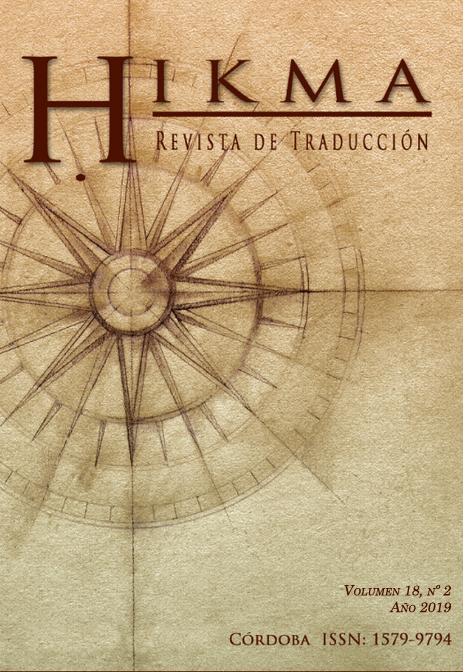Competencia cultural del receptor normovidente y audiodescripción
Main Article Content
Abstract
Downloads
Article Details

This work is licensed under a Creative Commons Attribution-NonCommercial-ShareAlike 4.0 International License.
Authors who publish with this journal agree to the following terms:
1. Authors retain copyright and grant the journal right of first publication with the work simultaneously licensed under a Creative Commons Attribution License that allows others to share the work with an acknowledgement of the work's authorship and initial publication in this journal.
2. Authors are able to enter into separate, additional contractual arrangements for the non-exclusive distribution of the journal's published version of the work (e.g., post it to an institutional repository or publish it in a book), with an acknowledgement of its initial publication in this journal.
3. Authors are permitted and encouraged to post their work online (e.g., in institutional repositories or on their website) prior to and during the submission process, as it can lead to productive exchanges, as well as earlier and greater citation of published work (See The Effect of Open Access).
References
AENOR (2005): Norma UNE 153020. Audiodescripción Para Personas Con Discapacidad Visual. Requisitos Para La Audiodescripción y Elaboración de Audioguías, Madrid: AENOR.
Ballester, A. (2007): “Directores en la sombra: personajes y su caracterización en el guion audiodescrito de 'Todo sobre mi madre'“, en Jiménez Hurtado C. (ed.): Traducción y accesibilidad: subtitulación para sordos y audiodescripción para ciegos: nuevas modalidades de traducción audiovisual. Frankfurt: Peter Lang, pp. 133-151.
Benecke, B. y E. Dosch (2004): Wenn Aus Bildern Worte Werden, Munich: Bayerishe Rundfunk.
CESYA, (Centro Español De Subtitulado Y Audiodescripción) (2015): Informe de seguimiento del subtitulado y la audiodescripción en la TDT. Año 2014, Madrid: Real Patronato sobre Discapacidad. Disponible en: http://www.cesya.es/sites/default/files/documentos/informeaccesibilidadtdt2014.pdf. [última consulta: 2 de abril de 2017]
Fresno, N. (2014): La (re)construcción de los personajes fílmicos en la audiodescripción. efectos de la cantidad de información y de su segmentación en el recuerdo de sus receptores. Tesis doctoral. Barcelona, Universitat Autònoma de Barcelona.
Fryer, L. y J. Freeman (2012): “Presence in those with and without sight: audio description and its potential for virtual reality applications”, Journal Of Cyber Therapy & Rehabilitations, 5(1), pp. 15-23.
Fryer, L. y J. Freeman (2013): “Cinematic language and the description of film: keeping ad users in frame”, Perspectives: Studies In Translatology, 21 (3), pp. 412-426. DOI: https://doi.org/10.1080/0907676X.2012.693108
Fryer, L. y P. Romero Fresco (2014): “Audiointroductions”, en A. Maszerowska, A. Matamala y P. Orero (eds.): Audio description: new perspectives illustrated, Amsterdam: Benjamins, pp. 11-28. DOI: https://doi.org/10.1075/btl.112.02fry
Gonant, F. y L. Morisset (2008): La charte de l’audiodescription, París: Ministère Des Affaires Sociales.
Hernández Sampieri R., C. Fernández Collado y P. Baptista Lucio (2006): Metodología de la investigación, Cuarta edición, México: Mc Graw Hill.
Independent Television Commission (2000): Guidance On Standards For Audio Description. [disponible en: http://stakeholders.ofcom.org.uk/binaries/broadcast/guidance/itcguide_sds_audio_desc_word.doc, fecha de consulta: 4 de diciembre de 2018].
Hopkins, D. (1989): Investigación en el aula. Guía del profesor, Promociones y Publicaciones Universitarias PPU.
Kumar, R. (2005): Research Methodology. A step-by-step guide for beginners, Londres: Sage.
Maszerowska, A. y C. Mangiron (2014): “Strategies for dealing with cultural references in audio description”, A. Maszerowska, A. Matamala y P. Orero (eds.): Audio description: new perspectives illustrated, Amsterdam: Benjamins, pp. 159-178. DOI: https://doi.org/10.1075/btl.112.10mas
Matamala, A, (2014): “Audio describing text on screen”, A. Maszerowska, A. Matamala y P. Orero (eds.): Audio description. New perspectives illustrated. Amsterdam: Benjamins, pp. 121-140. DOI: https://doi.org/10.1075/btl.112.07mat
Matamala, A. y A. Remael (2015): “Audio-description reloaded: an analysis of visual scenes in 2012 and hero”, Translation Studies, 8(1), pp. 63-81. DOI: https://doi.org/10.1080/14781700.2014.943678
Mazur, I. (2014): “Gestures and facial expressions in audio description”, en A. Maszerowska, A. Matamala y P. Orero (eds.): Audio description. New perspectives illustrated, Amsterdam: Benjamins, pp. 179-197. DOI: https://doi.org/10.1075/btl.112.11maz
Romero Fresco, P. y L. Fryer (2013): “Could audio-described films benefit from audio introductions? An audience response study”, Journal Of Visual Impairment And Blindness, 107(4), pp. 287- 285. DOI: https://doi.org/10.1177/0145482X1310700405
Navarrete-Galiano, R. (2012): “La piel que habito: nueva creación literaria, pictórica y escultórica de almodóvar”, en José Luis Crespo Fajardo (coord.), Arte y cultura digital. Planteamientos para una nueva era, Málaga: Grupo de investigación eumed.net: pp. 74-86.
Remael, A., N. Reviers y G. Vercauteren (eds.) (2015): Pictures painted in words. ADLAB audio description guidelines, Trieste: Edizioni Università di Trieste.
Snyder, Joel (2010): Audio description guidelines and best practice. American Council of the Blind. Disponible en: http://www.acb.org/adp/guidelines.html [última consulta: 2 de abril de 2017].
Sanz Moreno, R. (2019): “How to deal with intertextuality in audio description?” The skin I live in (Almodóvar, 2011): a case study, InTRAlinea nº 21.
Sanz Moreno, R. (2018): “Percepción de referentes culturales audiovisuales por parte de una audiencia normovidente”, Sendebar, vol. 29, pp. 129-145. DOI: https://doi.org/10.30827/sendebar.v29i0.6585
Szarkowska, A. y A. Jankowska (2015): “Audio describing foreign films”, The journal of specialised translation (23), january 2015, pp. 243-269.
Szarkowska, A. y P. Orero (2014): “The importance of sound in audio description”, en A. Maszerowska, A. Matamala y P. Orero (eds.): Audio description: new perspectives illustrated, Amsterdam: Benjamins, pp. 121-140. DOI: https://doi.org/10.1075/btl.112.08sza
Taylor, C. (2014): “Intertextuality”, en A. Maszerowska, A. Matamala y P. Orero (eds.): Audio description. New perspectives illustrated, Amsterdam/ Filadelfia: Benjamins, pp. 29-40. DOI: https://doi.org/10.1075/btl.112.03tay
Taylor, C. (2015: “Intertextual references”, en A. Remael, N. Reviers y G. Vercauteren (eds.): Pictures painted in words. ADLAB audio description guidelines, Trieste: Edizioni Università di Trieste, pp. 42-46.
Valero Gisbert, M.J. (2012): "La intertextualidad fílmica en la audiodescripción (ad)", InTRalinea vol. 14. url: http://www.intralinea.org/archive/article/1889
Vercauteren, G. y Pilar Orero (2013): “Describing facial expressions: much more than meets the eye”, Quaderns. Revista de Traducció (20), pp. 187-199.

